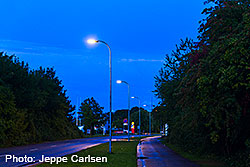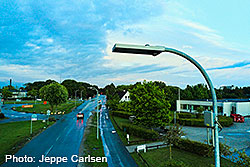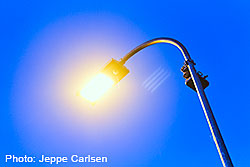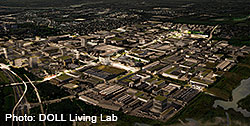Living Lab for intelligent outdoor lighting
Sustainable street lighting for the smart city
Scientists, city planners and lighting engineers are testing the latest developments for smart city applications in the “DOLL Living Lab”. Located in Albertslund, a suburb of Copenhagen, this combined test centre, exhibition space and innovation hub is Europe’s largest facility of its kind. Lighting technology provider Tridonic has initiated a three-year pilot project here to test new, intelligent solutions for sustainable outdoor lighting with the aim of enabling towns and cities to achieve significant cost savings and to offer new services for an intelligent lighting infrastructure that takes into account people and nature alike.
At the DOLL Living Lab in Copenhagen, Tridonic is working together with outdoor luminaire manufacturer WE-EF and IoT solutions specialist Paradox Engineering to establish the technical principles for intelligent connected city lighting.
The luminaires have three interfaces for the sensor and communication modules. Tridonic’s new D4i- and Zhaga-compatible RF Multimaster Controller handles communication between the luminaires.
The interfaces on the underside of the luminaire housings were equipped with PIR multisensors developed specifically for street lighting. With two PIR elements and asymmetric lenses, they can capture two separate areas, as is the case at the test track.
The pilot project covers a single-lane approach road to Copenhagen on the outskirts between a commercial area and a residential area. The road is flanked on one side by a pedestrian and cycle path. A total of 23 WE-EF VFL540-SE LED street lights have been installed over a length of around 800 metres. They are equipped with tunable white technology with continuous colour temperature control from 2,700 K to 6,000 K and intelligent Tridonic components. The luminaires have three Zhaga Book 18 interfaces for the sensor and communication modules. Tridonic’s new D4i- and Zhaga-compatible RF Multimaster Controller handles communication between the luminaires. In the initial test phase the interfaces on the underside of the luminaire housings were equipped with PIR sensors. Tridonic has developed these multisensors specifically for street lighting. They have two PIR elements with asymmetric lenses, which enable two separate areas to be detected, as is the case on the DOLL test track. The outdoor drivers developed according to the D4i standard allow the lights to be easily integrated in IoT networks. The system is monitored and controlled by Paradox Engineering’s “PE Smart Urban Network”. Based on standards and open data models, it offers complete interoperability in the management of devices, data and applications.
State of the art with a view to the future
In the first test phase, three use cases were defined and tested, leading to a new, series-ready Tridonic outdoor lighting solution for towns and cities. The “SIDEREA – Citizen Centric Lighting” system solution offers a comprehensive portfolio based on open standards for digital, resource-saving street lighting in the smart city of tomorrow. And that includes such things as asset management for monitoring the luminaires in real time, light on demand for minimising energy consumption and light emissions, and dynamic lighting with adaptive colour temperatures for raising alertness and arousing emotions. Towns and cities have the opportunity to integrate intelligent control into their urban network when upgrading their lighting to LED technology. Or if their budget does not allow for a full upgrade at the time of modernisation they can at least factor that in because the intelligent control components can be retrofitted in any luminaire bearing the D4i seal.
In the current test phase Tridonic is involved in further developing the lighting as part of a digitally connected city. Tests are being carried out to see how traffic-dependent lighting control for motorways could be integrated in an urban network. Integration of traffic lights – as described above – is also planned. Modern sensor technology is used to measure traffic flows and traffic densities and adapt the lighting levels to the current situation. A sensor with an integrated mini camera scans a fixed and defined road situation. However, it does not send the data to the cloud but processes it decentrally at the edge of the network into usable information with no personal data; only then does it pass it on. With traffic flow-dependent dimming, the CO2 footprint of the street lighting can be further minimised – always with the proviso that safety is not compromised for any road user. And there’s another element with a long-term reach: if the sensors were to operate with a self-learning algorithm they could continue to evolve in processing the incoming data and deliver ever more precise results.
Press contact:

Tridonic GmbH & Co KG
Färbergasse 15
6851 Dornbirn, Austria
Tel. +43 5572 395-45236
Mobile +43 664 80892 6313





